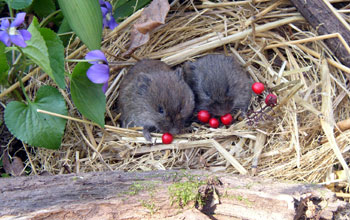Multimedia Gallery
Gene Manipulation
Gene Manipulation
These normally promiscuous meadow voles were coaxed to form monogamous pair bonds by manipulating a single gene--the Vasopressin receptor.
More about this Image
Researchers at the Center for Behavioral Neuroscience (CBN) in Atlanta, Ga., a National Science Foundation Science and Technology Center, in conjunction with the Yerkes National Primate Research Center of Emory University, discovered that transferring the Vasopressin receptor into the brain's reward center makes a promiscuous male meadow vole monogamous.
Researchers wondered why prairie voles form lifelong social or monogamous pair bonds with a single mate, but the comparative species of vole--the meadow vole, is promiscuous and frequently mates with multiple partners.
Previous studies of monogamous male prairie voles showed that the animals' brains contain high levels of vasopressin receptors in one of the brain's principal reward regions, the ventral pallidum. But the promiscuous meadow vole lacks vasopressin receptors in the ventral pallidum. Could differences in vasopressin receptor levels between prairie and meadow voles explain their opposite mating behaviors?
In order to find out, scientists used a harmless virus to transfer the vasopressin receptor gene from prairie voles into the ventral pallidum of meadow voles. This increased vasopressin receptors in the meadow vole to prairie-like levels. The researchers discovered that the formerly promiscuous meadow voles were now just like prairie voles, displaying a strong preference for their current partners rather than for new females.
Researchers hope that these findings may help better explain the neurobiology of romantic love as well as disorders of the ability to form social bonds, like autism. The findings also support previous research linking social bond formation with drug addiction, also associated with the reward center of the brain. (Date of Image: 2004)
Credit: Larry J. Young, Emory University
Images and other media in the National Science Foundation Multimedia Gallery are available for use in print and electronic material by NSF employees, members of the media, university staff, teachers and the general public. All media in the gallery are intended for personal, educational and nonprofit/non-commercial use only.
Images credited to the National Science Foundation, a federal agency, are in the public domain. The images were created by employees of the United States Government as part of their official duties or prepared by contractors as "works for hire" for NSF. You may freely use NSF-credited images and, at your discretion, credit NSF with a "Courtesy: National Science Foundation" notation.
Additional information about general usage can be found in Conditions.
Also Available:
Download the high-resolution JPG version of the image. (2.2 MB)
Use your mouse to right-click (Mac users may need to Ctrl-click) the link above and choose the option that will save the file or target to your computer.



